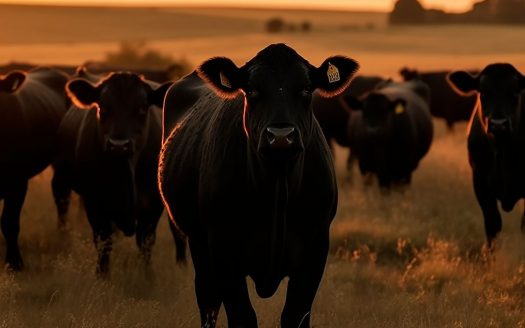How to Rent Out Your Ranch for Extra Income | United Country Real Estate
How to Rent Out Your Ranch for Extra Income
Do you own a ranch that you’re not utilizing to its fullest potential?
Have you considered renting it out for extra income?
Around 44.37% of America’s rural land is used for farming, and farmers are often looking for more land to rent for growing their crops. If you want to rent out your land for farming, there are two popular ways to do it.
The first way is a cash rent lease. In this method, you set a fixed amount per acre that the farmer pays you. The farmer can either pay this amount all at once, or pay half of it at the start of the farming season and the rest after they’ve collected their crops.
The second popular method is a crop share lease. Here, the farmer gives you a certain portion of the money they make from farming your land. For example, they might give you one-third of all their profits and keep the other two-thirds for themselves. As the landowner, you usually also help cover some of the costs of farming the land, depending on the share of the profits you’re getting.
With the rise of agritourism, it’s never been easier to turn your land into a profitable venture. Ranch owners have been finding creative ways to generate revenue for years. From selling produce to hosting weddings, there are countless opportunities to make money off of your land.
However, one of the most lucrative options is renting out your ranch for events or camping. If you’re interested in renting out your ranch for extra income, it’s important to know how to get started.
This guide will cover everything you need to know, from finding the right renters to marketing your property. With these tips, you’ll be well on your way to turning your ranch into a profitable business.
Related: Benefits of Living in a Ranch
1. Select an Arrangement
Determine whether you prefer receiving payment upfront or would like to have a share in both the expenditures and profits of the crop yield. Each of these agreements holds its own merits and demerits, and the best choice ultimately rests on your personal preference.
In an upfront cash arrangement, the local farmers or ranchers renting the land and the landowner engage in a negotiation to arrive at a per-acre price. This price is established considering factors such as the value of the land and its potential agricultural productivity. Once a consensus is reached and the payment is received by the landowner, the farmer generally retains considerable liberty in making decisions related to the farm’s management.
Alternatively, there’s the option of a shared crop arrangement. Under this system, both the landowner and the farmer divide the costs and profits of the farming enterprise. The typical division sees one-third of the costs and profits allocated to the landowner, with the remaining two-thirds designated for the tenant farmer.
If you find yourself wavering between the two models, this guide serves to provide comprehensive assistance. It aims to clarify any uncertainties and help you select the most suitable arrangement for your specific needs and preferences.
Some ranch owners prefer to rent out their entire property while others prefer to rent out specific areas or amenities on their ranch. You’ll also need to decide whether you want to handle the rental process yourself or work with a property management company.
Ultimately, the arrangement you choose will depend on your goals, budget and comfort level with managing rental properties.
2. Market the Land
There are a myriad of strategies you can employ to advertise your property effectively. Utilizing online platforms or local newspapers to post advertisements is a conventional method. Alternatively, distributing flyers at places frequented by the local community, such as co-operatives, eateries, or stores, or even the farmers market can also be an effective marketing approach.
When crafting your advertisement, it’s essential to provide thorough and detailed information. Potential tenants will be interested in knowing what facilities or structures on the property will be accessible to them.
How convenient is it for a farmer to reach the arable land?
Are there any water resources available on the property for use?
These are the types of questions prospective tenants will seek answers to in your advertisement.
However, if you’d rather avoid public advertisements, a more personal route is also an option. You could leverage your existing network, reaching out to local farmers you’re acquainted with to see if they might know someone in search of land to rent. This approach not only saves you the effort of advertising but also provides a sense of trust and security through the personal connection.
Renting out your ranch for extra cash can be a smart way to use your land, but it is important to market it effectively.
Next, you need to identify your target market – do you want to rent to hunters, campers or those looking for outdoor events? Once you have identified your target audience, tailor your marketing efforts to them – use social media to showcase the beauty and opportunities of your land, create a website and consider attending local fairs or events to promote your property.
By effectively marketing your ranch, you can attract the right renters and generate extra income.
Related: Tips and Ideas for Updating an Old Ranch
3. Do Your Homework When Choosing a Farmer
As a potential landlord, it’s paramount that you instill trust in the farmer who will be renting your land. You want to ensure they’ll take proper care of it and conserve its resources. During the tenant selection process, it’s advisable to:
Conduct Interviews with Several Farmers or Ranchers
Just as you wouldn’t entrust your child to the first daycare you come across, you shouldn’t lease your land to the first interested farmer either. Engage with multiple farmers to understand their farming practices, gauge their attitudes, and determine who you feel most comfortable entrusting your property to.
Arrange In-person Meetings
Avoid leasing to someone you’ve not met in person. Invite prospective tenants to inspect the land. This provides an opportunity to discuss the lease terms, farming methods, duration of the lease, and negotiate the rental price. Face-to-face meetings can offer valuable insights into a person’s demeanor and commitment, which might not be apparent in a more impersonal exchange.
Verify References
If a prospective tenant has prior experience renting farmland, reaching out to their former landlords can provide invaluable feedback. These references can shed light on the farmer’s reliability, farming practices, and their overall conduct during the lease period.
Remember, the aim is not just to rent out your land but to establish a beneficial and sustainable relationship with the tenant farmer. Take the time to ensure that the farmer you select aligns with your values and expectations for the care and stewardship of your property.
4. Create a Strong Formal Lease Agreement
After identifying a tenant who meets all your requirements, the next crucial step is to prepare an agreement for leasing land. It’s vital to ensure that this lease is a formal document that clearly stipulates all terms of the agreement. While sample farming leases published by agricultural universities can serve as useful references, they should be viewed merely as a base to build upon.
Your lease should specify any particular conditions that you expect the farmer to comply with. For instance, if you desire the farme/rancher to retain some crops for late-season hunting, this needs to be explicitly mentioned in the lease agreement.
Similarly, the lease should delineate provisions pertaining to a potential sale of the land. In certain states, if a landlord decides to sell the rented property, the incoming buyer is legally obligated to respect the terms of any existing lease.
Finally, the lease should also establish your right to access the rented land for specific purposes such as hunting or simply visiting. It’s critical to lay out these details clearly and unequivocally in writing to avoid potential misunderstandings or disputes in the future. By comprehensively addressing all these points, you can ensure a lease agreement that is fair, transparent, and beneficial for both parties.
Related: Ranches: The Investment Opportunity You Don’t Want to Miss
5. Insurance and Taxes
By earning an income from your land, you effectively become a business owner. This status brings with it specific liability risks that could potentially lead to significant financial obligations. Therefore, procuring liability insurance serves as a fundamental safeguard against expenses stemming from incidents such as injuries or wrongful death that may occur on your property. Such a policy typically covers associated medical bills as well.
It’s advisable to consult with your insurance agent to understand the type of coverage that would be most appropriate for your situation. They can guide you on the insurance policies that can provide the most comprehensive protection against liabilities arising from renting out your land.
As for the tax implications of your new business venture, both income and estate taxes can be influenced by farm rental agreements. Taxation laws can be complex, and how you structure your rental agreement can have significant tax implications. To navigate this complex terrain effectively, consider seeking guidance from a tax consultant. They can provide valuable insights into the most beneficial ways to manage tax-related concerns pertaining to your farm rental venture. By securing the right insurance and understanding your tax obligations, you can ensure that your venture into land rental is not just profitable but also protected.
6. Adhere to the Lease Agreement
Renting out your ranch for extra income can be an excellent way to generate additional revenue, but it is essential to adhere to the lease to ensure a positive rental experience for both parties.
Before renting out your ranch, it’s crucial to establish clear lease terms with the tenant, including payment schedules, responsibilities for upkeep and repairs, and rules for property use.
Adhering to the lease protects you as the landlord and ensures that the tenant has a clear understanding of the expectations and requirements for the rental.
By following these guidelines, you can enjoy the benefits of renting your ranch and make the most of your investment.
Looking for a ranch property you can call home? Call United Country!






